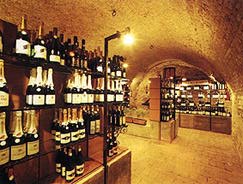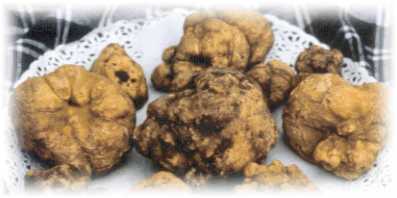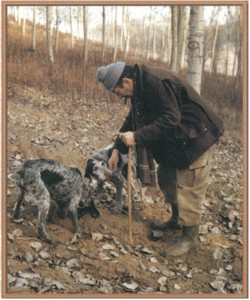
THE
LANGHE :
The
Langhe region is the heart of the Barolo, Dolcetto and Barbaresco wines
country and is located in the southern part of Piedmont. Clic
for a more detailed map of this region and for a larger
map showing the surrounding areas as well.
FOOD
: The cuisine of the Langhe, Monferrato and Roero
is so rich, despite its humble farmhouse origins, that it would be practically
impossible to speak of all the local dishes. Almost all those who have
opened restaurants in the hills - or even in Alba, Bra and Asti - have
left farms taking mother or grandmother along with them to cook the many
recipes that have been handed down over generations, not only in their
basic structure but also their most intimate secrets. Originating from
the very modest economic conditions that were endured through the centuries,
the area's gastronomy has gradually become more elaborate, whilst preserving
all the natural local ingredients and components. There are also more noble
and middle-class sources, but this school was subject to rural influences
too. In the area trim trattorias can be found alongside smart restaurants,
but they are all seeking to present good cooking matched by first-rate
wines.
WINES
: Vineyards grow just about everywhere on the hills
of the Langhe, Monferrato and  Roero.
They are a fundamental part of the landscape, the history and the customs:
in other words, of the economy and survival of the people in the villages
and farmsteads scattered over the territory.These vineyards yield up top
quality grapes for outstanding wines. Its powerful qualities make Barolo,
a d.o.c.g. (controlled and guaranteed denomination) wine, the greatest
wine in Italy and perhaps in the world, while Barbaresco, another of the
few d.o.c.g. status wines in Italy, is considered exceptional for the finesse
of its bouquet and flavour that match it perfectly with the great dishes
of the local cuisine. Barolo and Barbaresco are made from the grapes of
the Nebbiolo vine, which has also given its name to a wine that has been
celebrated since the 1600s when it was served at the court of the House
of Savoy, as well as to the more recent Roero denomination. Roero.
They are a fundamental part of the landscape, the history and the customs:
in other words, of the economy and survival of the people in the villages
and farmsteads scattered over the territory.These vineyards yield up top
quality grapes for outstanding wines. Its powerful qualities make Barolo,
a d.o.c.g. (controlled and guaranteed denomination) wine, the greatest
wine in Italy and perhaps in the world, while Barbaresco, another of the
few d.o.c.g. status wines in Italy, is considered exceptional for the finesse
of its bouquet and flavour that match it perfectly with the great dishes
of the local cuisine. Barolo and Barbaresco are made from the grapes of
the Nebbiolo vine, which has also given its name to a wine that has been
celebrated since the 1600s when it was served at the court of the House
of Savoy, as well as to the more recent Roero denomination.  Grignolino,
the typical wine grown on the hills of the Monferrato, is a highly-prized
wine with delicate features and a lasting bouquet.Dolcetto and Barbera
are two versatile wines that are grown throughout the region, particularly
the latter, which is equally at home on the slopes of the Langhe, Monferrato
or Roero.Among the dessert wines, the docg's Brachetto d'Asti - a refined
pleasure - Moscato and Asti Spumante, which are a common denominator of
both the Langhe and the Monferrato, while the Roero has its own sweet Brachetto:
unique, inimitable aromas and bouquets make these the most widely-exported
wines. Pelaverga's inviting bouquet is making it so popular that it has
now been awarded d.o.c. status. This is the land of red wines par excellence;
in the Roero, however, two attractively delicate, young white wines are
enjoying a huge success: Arneis, a d.o.c. wine, and Favorita. Grignolino,
the typical wine grown on the hills of the Monferrato, is a highly-prized
wine with delicate features and a lasting bouquet.Dolcetto and Barbera
are two versatile wines that are grown throughout the region, particularly
the latter, which is equally at home on the slopes of the Langhe, Monferrato
or Roero.Among the dessert wines, the docg's Brachetto d'Asti - a refined
pleasure - Moscato and Asti Spumante, which are a common denominator of
both the Langhe and the Monferrato, while the Roero has its own sweet Brachetto:
unique, inimitable aromas and bouquets make these the most widely-exported
wines. Pelaverga's inviting bouquet is making it so popular that it has
now been awarded d.o.c. status. This is the land of red wines par excellence;
in the Roero, however, two attractively delicate, young white wines are
enjoying a huge success: Arneis, a d.o.c. wine, and Favorita.
 TRUFFLES:
The white truffle, scientifically known as 'tuber magnatum Pico', is an
underground fungus belonging to the ascomycetes family. The truffle grows
in symbiosis with certain trees, in particular oaks, willows, limes and
poplars. Its delicacy, intensity of aroma and colour, which can be as dark
as milk coffee with pale streaks, may vary depending on the plant it grows
under.Every truffle-hunter knows spots where the precious fungus can develop,
and the secrecy surrounding the search - which begins by law on 15 September
and ends on 31 January, although the 'tuber magnatum Pico' reaches its
peak in terms of quality towards the end of autumn - is legendary. TRUFFLES:
The white truffle, scientifically known as 'tuber magnatum Pico', is an
underground fungus belonging to the ascomycetes family. The truffle grows
in symbiosis with certain trees, in particular oaks, willows, limes and
poplars. Its delicacy, intensity of aroma and colour, which can be as dark
as milk coffee with pale streaks, may vary depending on the plant it grows
under.Every truffle-hunter knows spots where the precious fungus can develop,
and the secrecy surrounding the search - which begins by law on 15 September
and ends on 31 January, although the 'tuber magnatum Pico' reaches its
peak in terms of quality towards the end of autumn - is legendary.
The
market has its own special ritual too: the truffles are shown with circumspection,
and can only be purchased following direct contact between buyer and seller.
Truffles are at their best eaten fresh, and their aroma is brought out
to the full by simple hot dishes such as fondue, risottos, 'tajarin' pasta,
poached egg.
Ingenious,
imaginative restaurants will recommend other fine combinations. Depending
on the season, white truffles can be kept for from 10 to 20 days.The fresher
they are, the more fragrant they will be..
|
|
|



